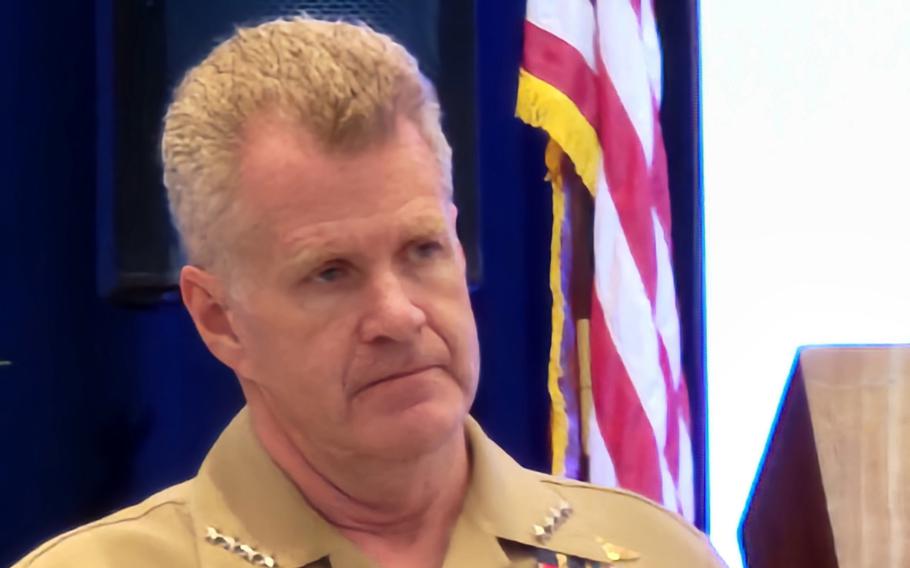
Adm. Samuel Paparo, head of U.S. Indo-Pacific Command, fields audience questions at the Honolulu Defense Forum on Waikiki Beach, Hawaii, on Feb. 13, 2025. (Wyatt Olson/Stars and Stripes)
ALOHILANI RESORT WAIKIKI BEACH, Hawaii — The United States and its allies face an “emerging axis of autocracy” with China, Russia and North Korea assisting each other in their military ambitions, the top U.S. military commander in the Indo-Pacific said Thursday.
“The People’s Republic of China, Russia and North Korea have formed a triangle of troublemakers,” Adm. Samuel Paparo, commander of U.S. Indo-Pacific Command, said during a keynote speech at the annual Honolulu Defense Forum.
“Their joint naval exercises grow more sophisticated in the Northeastern Pacific,” he said. “Their technology transfers increase in scope and in scale, and their diplomatic cooperation threatens to transform the Pacific from free and open to contested and controlled.”
Hosted by the Honolulu-based Pacific Forum think tank, the three-day forum focuses on “leveraging geography, private-public partnerships and the power of alliances and partnerships to strengthen resilience and enhance deterrence.”
The audience included a wide swath of the defense industry and military officials from the U.S. and allied and partner nations.
“To be direct, our current posture faces serious challenges that directly threaten the security, the freedom, the well-being of the United States and of our allies and partners,” Paparo said. “And if you are in this room, within the earshot of my voice, you, your family, are directly threatened.”
Paparo, former head of Pacific Fleet before assuming command of INDOPACOM in May, ticked off a litany of ways the People’s Republic of China, or PRC, Russia and North Korea are mutually extending their military reach.
“Presently, Russia, in its aggression against Ukraine, would be unable to support this aggression were the PRC not supporting it with 90% of its semiconductors and 70% of its machine tools,” Paparo said.
“And coming back to the PRC is going to be submarine quieting technology,” he said. “There’s going to be shared technology in aviation. This is a transactional symbiosis between these two states that’s going to make each of them stronger, and each of them is going to look to exploit the other because they’re states.”
Meanwhile, North Korea has sent thousands of infantry troops, along with K-24 short-range ballistic missiles and 170-mm artillery, to Ukraine to assist Russia in its invasion of that European nation, he said.
In turn, North Korea is expecting Russia will share the technology underpinning its Kilo-class attack submarines, he said.
Coordination among those three nations extends to “everything from joint bomber patrols that penetrate America’s [air defense identification zone] to shared anti-satellite capabilities and advanced submarine technologies -- from the seabed to the heavens,” Paparo said.
Paparo’s assessment of where America’s armed forces stand in the face of this trifecta was stark.
“Our magazines run low,” he said. “Our maintenance backlogs grow longer each month for every critical joint-force element -- Army, Navy, Air Force, Marines, Space Force, Coast Guard. Critical air, missile, maritime [and] space platforms age faster than we can replace them currently, and we operate on increasingly thin margins for error.”
However, America’s alliances with Indo-Pacific nations, particularly Japan, South Korea and Australia, would be a “significant” advantage in any future conflicts, he said.
“We hold generational advantages in space, counterspace, and in cyber, and these can and will deliver decisive war-winning advantages,” he said.